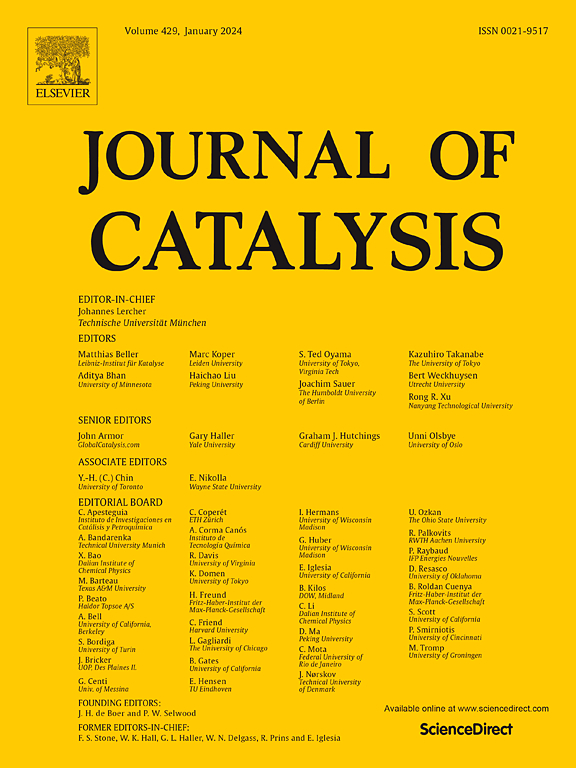Unveiling the pathways and site requirements of methanol oxidative dehydrogenation on MoO3/TiO2 catalysts: An operando-FTIR study
IF 6.5
1区 化学
Q2 CHEMISTRY, PHYSICAL
引用次数: 0
Abstract
Methanol oxidative dehydrogenation was studied on sub-monolayer and crystalline MoO3/TiO2-supported catalysts using operando-FTIR spectroscopy. Results revealed two distinct methyl formate (MF) formation pathways, determined by the molybdenum oxide structure. Quantitative and qualitative evidence indicated that MF and dimethoxymethane (DMM) formation occur via distinct reaction intermediates. MF formation is linked to surface formate consumption, supported by the similarity between steady-state MF formation rate measured in a fixed-bed reactor and transient initial formate consumption rate determined by operando-FTIR. Apparent activation energies for HCOO* consumption (90 and 88 kJ mol−1) and MF formation (83 and 51 kJ mol−1) for 2.5 and 15 at. Mo nm−2 samples, respectively, indicate that the formation pathway depends on the molybdenum oxide structure. Oligomeric, octahedral molybdenum oxide catalysts produce MF via adsorbed formate consumption, while crystalline MoO3 catalysts enable a parallel pathway, likely involving hemiacetal intermediates. This change in reaction pathway correlates with the structural transition from oligomeric to crystalline molybdenum oxide, as characterized by XRD, in situ Raman spectroscopy, FTIR of low-temperature CO adsorption, and XPS, among other techniques. The increase of surface formate consumption is related to the enhancement of the redox properties of the catalyst, attributed to interactions of molybdenum oxide with titania support and the presence of readily reducible Mo6+ sites that influence adsorbed formaldehyde reaction pathways. The observed activity and selectivity are explained by a three-active-site mechanism: molybdenum oxide redox sites for methanol dehydrogenation, molybdenum oxide acid sites for hemiacetal and DMM formation, and molybdenum-titania interfacial sites for HCOO* and MF formation.


求助全文
约1分钟内获得全文
求助全文
来源期刊

Journal of Catalysis
工程技术-工程:化工
CiteScore
12.30
自引率
5.50%
发文量
447
审稿时长
31 days
期刊介绍:
The Journal of Catalysis publishes scholarly articles on both heterogeneous and homogeneous catalysis, covering a wide range of chemical transformations. These include various types of catalysis, such as those mediated by photons, plasmons, and electrons. The focus of the studies is to understand the relationship between catalytic function and the underlying chemical properties of surfaces and metal complexes.
The articles in the journal offer innovative concepts and explore the synthesis and kinetics of inorganic solids and homogeneous complexes. Furthermore, they discuss spectroscopic techniques for characterizing catalysts, investigate the interaction of probes and reacting species with catalysts, and employ theoretical methods.
The research presented in the journal should have direct relevance to the field of catalytic processes, addressing either fundamental aspects or applications of catalysis.
 求助内容:
求助内容: 应助结果提醒方式:
应助结果提醒方式:


